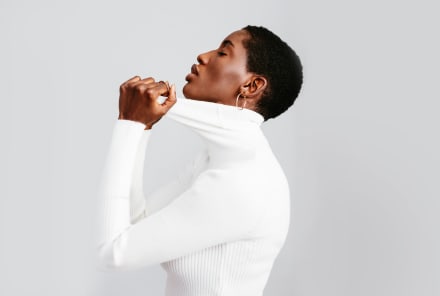Advertisement
It's Called The "Sunshine Vitamin," But Can You Get Vitamin D Through A Window?


The body can produce vitamin D on its own. However, regular and adequate exposure to ultraviolet rays (like those found in certain UVB wavelengths of sunlight during certain times of the year at key latitudes and depending on your skin tone, how much you're wearing, your sunscreen coverage—you get the point, vitamin D from sun isn't as simple as it seems) is required to kick-start the process.
But for those who can't get outside as often as they'd like, there's a lot of curiosity around what exactly counts as sun exposure. Can you get vitamin D through a window?
We consulted experts in nutrition science to see exactly how the sunshine-to-vitamin-D pipeline works, plus how much sun exposure is needed to support sufficient vitamin D status.
Can you get vitamin D through a window?
While sitting near a sunny window might feel similar to getting outside, it's no substitute for direct sun exposure.
"Window glass absorbs all UVB radiation. You make no vitamin D [this way]," says professor of medicine, physiology, and biophysics at Boston University medical center Michael Holick, M.D., Ph.D., who authored foundational research on vitamin D synthesis4 in the 1980s and has continued to lead the evidence-based conversation on vitamin D.
But as we alluded to before, even direct sun exposure isn't a foolproof way to produce vitamin D. As Holick explains, sunscreen and shade (which are important for protection against other skin health concerns) will get in the way, and location, altitude, season, skin tone, age, and time of day have to be considered as well.
"For many people, sun exposure will simply not be enough to provide the vitamin D that your body needs," says Victoria J. Drake, Ph.D.5, manager of the Micronutrient Information Center at the Linus Pauling Institute of Oregon State University. "Anyone who uses sunscreen to protect from the unwanted effects of sun exposure or spends a limited time outside, especially in the midday summer sun, may not be getting enough."
She notes also that an SPF of just 15 can slash vitamin D production by over 90%6. (And to be clear: We are fans of smart and intentional sun protection practices.)
Season and location can limit vitamin D production even more severely. "If you are in Boston in the wintertime and you go outside for 15 minutes, you make zero vitamin D. In fact, you make no vitamin D from about November until the following March," Holick explains. "Unless you're going to be a lifeguard or a hunter-gatherer, you're not going to make very much vitamin D." (And even the lifeguard and forager aren't making vitamin D from the sun in the northern latitudes for several months of the year).
For people with darker skin tones, sunlight is an even less reliable source of vitamin D, as the presence of melanin naturally reduces vitamin D production in the skin.
While 29% of U.S. adults7 are deficient in vitamin D, Black Americans are 15 to 20 times more likely8 to be extremely deficient [i.e., have serum 25-hydroxyvitamin D levels—that's 25(OH)D for short—below 10 ng/ml]. For reference, 25(OH)D is your serum biomarker (i.e., from a blood test) of vitamin D status in your entire body.
So, the answer is no—you can't get vitamin D through a window. Ultimately, the question isn't even that consequential, considering experts agree we shouldn't be relying on sunlight as our sole source of vitamin D anyway.
Unless, perhaps, you live close to the equator and spend most of your day in a bathing suit on the beach, you'll have to turn to other high-quality, daily sources of D to reach sufficient vitamin D levels—and to reach truly optimal vitamin D status (i.e., at or above 50 ng/ml), smart supplementation is the way to go.*
Summary
Other sources of vitamin D
When it comes to food, fortified milk and orange juice, as well as egg yolks and some kinds of (UV-irradiated) mushrooms contain small (as in, practically obsolete) amounts of vitamin D2 (the much less bioavailable and efficacious form of the micronutrient). Native food sources of vitamin D3 include some fatty fish—like salmon, for example.
Even just to meet the baseline recommended dietary allowance (i.e., 600 IU for healthy adults, per the National Academies) to avoid bone health problems, one would have to drink more than six glasses of fortified milk9 a day, 12 whole eggs10, or a 3.5-ounce serving of sockeye salmon11, and experts agree—600 IU is not remotely enough of the fat-soluble nutrient to move the needle on vitamin D status in order to reach (and maintain!) healthy levels.
As mentioned earlier, nationwide rates of frank vitamin D deficiency and insufficiency [i.e., 25(OH)D blood test results less than 20 ng/ml or 30 ng/ml] among adults is 29% and 41%7, respectively. But racial inequities clearly exist, with 82% of Black Americans12 and nearly 70% of Latino Americans12 experiencing D deficiency.
With this in mind, Holick recommends all his clients take a vitamin D supplement daily, no matter the season. Drake agrees, stating the Linus Pauling Institute recommends generally healthy adults take 2,000 IU of supplemental vitamin D every day but noting that reaching ideal blood levels of vitamin D (i.e., above the 30 ng/ml "danger zone" for insufficiency and into that coveted 50 ng/ml range) may require an even higher dosage of supplementation.
mbg's vice president of scientific affairs Ashley Jordan Ferira, Ph.D., RDN, breaks down exactly how much vitamin D we need to achieve healthy serum levels: "Pharmacokinetic research14 shows that it takes 100 IU of vitamin D to increase a normal-weight adult's serum D levels by about 10 ng/ml.
So, that means that in order to achieve 50 ng/ml, you need 5,000 IU of vitamin D per day." She elaborates, saying "Given that two-thirds of our nation is dealing with overweight or obesity, our daily vitamin D needs as a country are actually higher—but 5,000 IU is a great starting point."
If you're trying to do some quick mental calculations to determine how many servings of milk, eggs, or fish you'd need to eat to consume 5,000 IU of vitamin D daily, we'll save you the trouble—it's a lot. Too much, one would be fair to argue. Simply put, daily vitamin D supplementation is the most effective way to reach sufficient vitamin D levels and maintain whole-body health.*
(Looking for a truly effective D3 supplement that will help you achieve sufficient vitamin D status and keep it there? Check out our vitamin D supplement roundup.)
Summary
Why is vitamin D important?
Now that we've reviewed where you can get your vitamin D and how much you need to optimize your health and well-being, let's discuss the many benefits you can look forward to upon achieving healthy D status.
Bone health benefits
Vitamin D is perhaps most well known for its role in maintaining bone health because the body needs it to absorb calcium and maintain healthy phosphorus levels15.* Ferira adds, "Vitamin D is required by the body for optimal calcium and phosphorus homeostasis—which, in turn, impacts bone mineralization and so much more."* Vitamin D has long been a go-to nutrient for supporting bone mineral density (particularly as we age), and more recently, it's also been linked to supporting musculoskeletal health and even improving muscle strength.*
Heart-health benefits
Evidence suggests that vitamin D plays an important role in bolstering cardiovascular integrity16 and promoting overall heart health.* As demonstrated in a 2019 Biology scientific review17, this cardiovascular support can be attributed, in part, to vitamin D's role in antioxidant and anti-inflammatory actions throughout the body, which help combat oxidative stress.*
Immune health benefits
As far as the immune system is concerned, vitamin D has been shown to support white blood cell function18 and mediate immune cells' response19.* The science is clear: Vitamin D is a key and powerful regulator of healthy immune function and an important tool for maintaining whole-body health throughout the year.*
As Ferira previously shared with mbg, this micronutrient is both a "vitamin and immunomodulator that wears many hats. Involved in innate and adaptive immune responses, the vitamin D receptor has been discovered in the majority of immune cells, and vitamin D demonstrates immunosuppressant, anti-inflammatory, antibacterial, and antiviral actions."*
Longevity benefits
Thanks to its many important roles in maintaining overall health—including DNA protection17 and promoting antioxidant activity—vitamin D is a huge factor when it comes to supporting longevity outcomes.* In fact, a 2014 meta-analysis20 exploring vitamin D levels and health span found that those with higher levels of vitamin D were significantly more likely to live longer, healthier lives.*
More recently, a groundbreaking study conducted in Germany21 found vitamin D supplementation can literally add years to life and health span in older adults deficient in the essential vitamin.*
Mood support
Vitamin D supplementation gets a lot of hype in the gray days of winter, when the mood-boosting benefits of sunshine are inaccessible—and for good reason. A 2020 review22 of 61 studies published in the Indian Journal of Psychological Medicine found that people with mood concerns often have lower levels of vitamin D (i.e., worse vitamin D status) than their happier counterparts.*
In another study from the Journal of Internal Medicine, the potential mood-supporting effects of vitamin D supplements were tested against a placebo in over 300 Norwegian adults. After one year, those who received the vitamin D supplement showed significant improvements in their mood, while those in the control group (i.e., no vitamin D supplement) experienced no such benefits.*
The takeaway
Despite the slew of health benefits associated with optimal vitamin D levels, most people fail to get enough vitamin D from sun exposure or food sources alone. And if you thought sitting by a sunny window would help, well, sorry, you're out of luck.
Experts recommend turning to high-quality vitamin D supplements to achieve and sustain sufficiency levels, and we're partial to mindbodygreen's own vitamin D3 potency+.* With 5,000 IU of vitamin D3 sourced from organic algal oil and thoughtfully paired with an organic trio of flax, avocado, and olive oils to support optimal absorption, our vitamin D is hard to beat.*
22 Sources
- https://www.ncbi.nlm.nih.gov/pmc/articles/PMC2669834/
- https://www.ncbi.nlm.nih.gov/pmc/articles/PMC5618598/
- https://www.ncbi.nlm.nih.gov/pmc/articles/PMC8318777/
- https://pubmed.ncbi.nlm.nih.gov/2839537/
- https://lpi.oregonstate.edu/mic/staff
- https://www.ncbi.nlm.nih.gov/pmc/articles/PMC4732611/
- https://www.cambridge.org/core/journals/british-journal-of-nutrition/article/vitamin-d-deficiency-and-insufficiency-among-us-adults-prevalence-predictors-and-clinical-implications/44E436843510FE6BDE856D5BCB9C651F
- https://www.ncbi.nlm.nih.gov/pmc/articles/PMC7913332/
- https://fdc.nal.usda.gov/fdc-app.html#/food-details/171268/nutrients
- https://fdc.nal.usda.gov/fdc-app.html#/food-details/748967/nutrients
- https://fdc.nal.usda.gov/fdc-app.html#/food-details/173692/nutrients
- https://pubmed.ncbi.nlm.nih.gov/21310306/
- https://www.ncbi.nlm.nih.gov/pmc/articles/PMC5579642/
- https://www.ncbi.nlm.nih.gov/pmc/articles/PMC4571146/
- https://pubmed.ncbi.nlm.nih.gov/26138833/
- https://www.ncbi.nlm.nih.gov/pmc/articles/PMC7555466/
- https://www.ncbi.nlm.nih.gov/pmc/articles/PMC6627346/
- https://www.ncbi.nlm.nih.gov/pmc/articles/PMC3604145/
- https://www.ncbi.nlm.nih.gov/pmc/articles/PMC3756814/
- https://www.ncbi.nlm.nih.gov/pmc/articles/PMC4103214/
- https://link.springer.com/article/10.1007/s11357-022-00581-9
- https://www.ncbi.nlm.nih.gov/pmc/articles/PMC6970300/

















